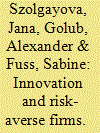|
|
|
Sort Order |
|
|
|
Items / Page
|
|
|
|
|
|
|
| Srl | Item |
| 1 |
ID:
132829


|
|
|
|
|
| Publication |
2014.
|
| Summary/Abstract |
In a regulated world where government seeks to decarbonize the energy sector, firms face both indirect and direct costs of emitting CO2. This study seeks to take the perspective of the firm, which needs to maximize profits implying minimization of (carbon) cost as well. In this study, the firm can compose the cost-optimal portfolio of (a) investing into carbon-saving technology, which is currently expensive, (b) investing into carbon-saving technology R&D and adopt this technology at a later point, (c) buying allowances per ton of emitted CO2 in a carbon market (alternatively this could be formulated as a tax), and (d) buying offsets traded in the same market, which are based on reduced emissions from deforestation and degradation (REDD+). Uncertainties in the cost of carbon coming from a lack of commitment in policy-making leading to fluctuations in markets and uncertainty in the payoff of R&D activities could provide disincentives to incur large up-front sunk cost and raise the economic value of being flexible. We apply a real options approach with stochastic carbon-saving technology costs and stochastic CO2 costs. Assuming that firms are risk-averse, they will not only value flexibility, but also risk reductions from diversification over the different (carbon mitigation) options.
|
|
|
|
|
|
|
|
|
|
|
|
|
|
|
|
| 2 |
ID:
111061


|
|
|
|
|
| Publication |
2012.
|
| Summary/Abstract |
Ongoing negotiations under the UNFCCC center around the possibilities for stabilization of greenhouse gases at a "safe" level. New energy technologies are assumed to make major contributions to this goal. However, in the light of scientific uncertainty (e.g. about climate sensitivity, feedback effects, etc.), market uncertainty (e.g. fuel price volatility), technological uncertainty (e.g. availability of renewable technology), socio-economic uncertainty (e.g. development of different macroeconomic factors) and policy uncertainty (e.g. about commitment to specific targets and stability of CO2 prices), it is difficult to assess the importance of different technologies in achieving robust long-term climate risk mitigation. One example currently debated in this context is biomass-based energy, which can be used to produce both carbon-neutral electricity and at the same time offer the possibility of "negative emissions" by capturing carbon from biomass combustion at the conversion facility and permanently storing it. In this study, we analyze the impact of uncertainty on investment decision-making at the plant level in a real options valuation framework, and then use the GGI Scenario Database (IIASA, 2009) as a point of departure for deriving optimal technology portfolios across different socio-economic scenarios for a range of stabilization targets, focusing, in particular, on the new, low-emission targets using alternative risk measures.
|
|
|
|
|
|
|
|
|
|
|
|
|
|
|
|
|
|
|
|
|